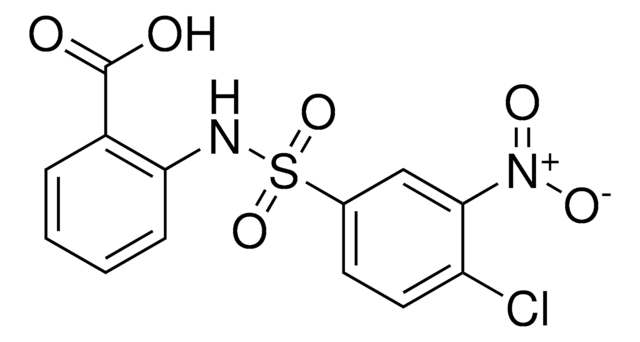B3561
BAY 73-6691
≥98% (HPLC), powder
Synonym(s):
1-(2-Chlorophenyl)-6-[(2R)-3,3,3-trifluoro-2-methylpropyl]-1,5-dihydro-4H-pyrazolo[3,4-d]pyrimidine-4-one
About This Item
Recommended Products
Quality Level
Assay
≥98% (HPLC)
form
powder
color
off-white
solubility
DMSO: >20 mg/mL
originator
Bayer
storage temp.
2-8°C
SMILES string
C[C@H](CC1=Nc2c(cnn2-c3ccccc3Cl)C(=O)N1)C(F)(F)F
InChI
1S/C15H12ClF3N4O/c1-8(15(17,18)19)6-12-21-13-9(14(24)22-12)7-20-23(13)11-5-3-2-4-10(11)16/h2-5,7-8H,6H2,1H3,(H,21,22,24)/t8-/m1/s1
InChI key
FFPXPXOAFQCNBS-MRVPVSSYSA-N
Application
Biochem/physiol Actions
Features and Benefits
Signal Word
Danger
Hazard Statements
Precautionary Statements
Hazard Classifications
Acute Tox. 2 Oral - Aquatic Chronic 4 - Eye Irrit. 2 - Skin Irrit. 2 - STOT SE 3
Target Organs
Respiratory system
Storage Class Code
6.1A - Combustible, acute toxic Cat. 1 and 2 / very toxic hazardous materials
WGK
WGK 3
Flash Point(F)
Not applicable
Flash Point(C)
Not applicable
Personal Protective Equipment
Certificates of Analysis (COA)
Search for Certificates of Analysis (COA) by entering the products Lot/Batch Number. Lot and Batch Numbers can be found on a product’s label following the words ‘Lot’ or ‘Batch’.
Already Own This Product?
Find documentation for the products that you have recently purchased in the Document Library.
Articles
Cyclic nucleotide phosphodiesterases (PDEs) catalyze the hydrolysis of cAMP and/or cGMP. There are 11 different mammalian PDE families.
Our team of scientists has experience in all areas of research including Life Science, Material Science, Chemical Synthesis, Chromatography, Analytical and many others.
Contact Technical Service





